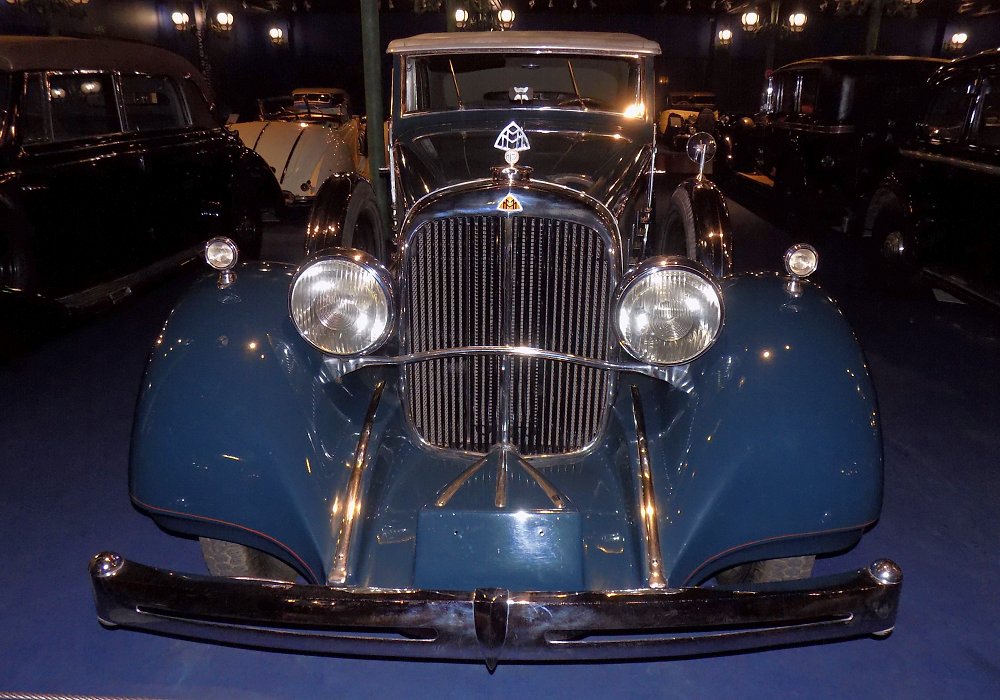Description
The Maybach DS 8 Graber Cabriolet was one of the most exquisite and rare coachbuilt interpretations ever created on Maybach’s greatest pre-war chassis. Combining the monumental engineering of the DS 8 Zeppelin with the refined Swiss artistry of Hermann Graber’s workshop in Wichtrach, it stood apart from the more common German-bodied examples by offering a cleaner, more modern, and more subtly elegant expression of open-top luxury. Where Spohn and Erdmann & Rossi favoured dramatic flourishes and imposing lines, Graber brought restraint, balance, and beautifully judged proportions, producing one of the most sophisticated Cabriolets ever mounted on a Maybach chassis.
At the core of the DS 8 Graber Cabriolet lay the extraordinary Maybach 8.0-litre V12 engine. This immense powerplant produced roughly 200 horsepower — a colossal figure for the early 1930s — and delivered its output with a refinement characteristic only of Maybach’s aero-engine heritage. Smooth, quiet and almost vibration-free, the V12 gave the lighter Graber body exceptional performance and serene cruising ability. Even when fitted with luxurious open coachwork, the DS 8 moved with effortless authority, its deep reservoir of torque allowing it to accelerate cleanly and maintain speed without strain.
The chassis employed a large, extremely rigid ladder frame paired with long semi-elliptic leaf springs. Designed primarily for stability and comfort under formal limousine bodies, it served the Cabriolet configuration equally well. The long wheelbase gave the car a dignified, sweeping stance and an exceptional ride quality. Although not intended as a sporting machine, the Graber body’s inherent lightness allowed the DS 8 to feel more responsive than its limousine siblings, making it one of the more engaging variants to drive.
Maybach’s dual-range gearbox provided a broad spread of gearing for both low-speed control and high-speed touring. The system was sophisticated for its time and reduced driver effort, allowing the chauffeur — or, unusually for a Maybach, the owner — to handle the large V12 with surprising ease.
It was Graber’s coachwork, however, that truly set this model apart. Hermann Graber was one of Europe’s most refined coachbuilders, known for an elegant, understated style that favoured harmony of line over theatrical ornament. On the DS 8 chassis, Graber produced a Cabriolet of remarkable purity. The wings flowed cleanly into the body without the dramatic exaggeration typical of German designs. The doors were long and beautifully balanced, the roofline — when raised — was taut and well proportioned, and the rear deck tapered gently to create a cohesive, timeless silhouette.
Graber’s metalwork was executed entirely by hand, with precision panel beating and meticulous finishing. The visual language was one of calm elegance: graceful curves, subtle chrome application, and perfectly judged proportions that disguised the enormous size of the DS 8 chassis. It was a more international design — closer in spirit to the finest Swiss, French and Italian work — and remains one of the most aesthetically refined bodies ever fitted to a Maybach.
Inside, the Cabriolet offered the same standard of bespoke luxury found throughout the DS 8 series. The cabin was upholstered in the finest leathers available, complemented by polished hardwood veneers, thick carpeting and beautifully machined metal fittings. Graber, known for his high-quality interior craftsmanship, created a cockpit that felt warm, cohesive and inviting rather than ostentatious. The rear seating area remained spacious and deeply comfortable, with optional amenities such as writing tables, vanity sets, cigarette cases, custom lighting and heater systems depending on the original client’s requirements.
On the road, the DS 8 Graber Cabriolet delivered remarkable refinement. The V12 moved the car with smooth, unhurried strength, and the suspension absorbed even poor surfaces with grace. The lighter body allowed slightly more responsiveness than the heavier German-bodied versions, but the overall impression remained one of dignified power and serene composure. Steering was steady and predictable, and braking — via large mechanical drums — was effective for the era.
Only an extremely small number of DS 8 chassis were bodied by Graber, making these Cabriolets among the rarest Maybachs ever built. Each was commissioned by a client of exceptional wealth who sought something more subtly stylish than the dramatic German coachwork usually associated with the Zeppelin series.
Today, the Maybach DS 8 Graber Cabriolet is regarded as one of the finest and most elegant expressions of the mighty DS 8 chassis. Extraordinarily rare, beautifully balanced in design and unmatched in its combination of Swiss craftsmanship and German engineering, it stands as one of the greatest open luxury cars of the pre-war era — a masterpiece of timeless restraint atop one of the most formidable mechanical foundations ever produced.

